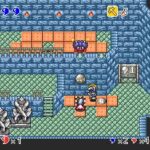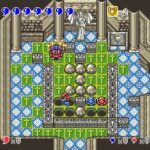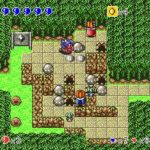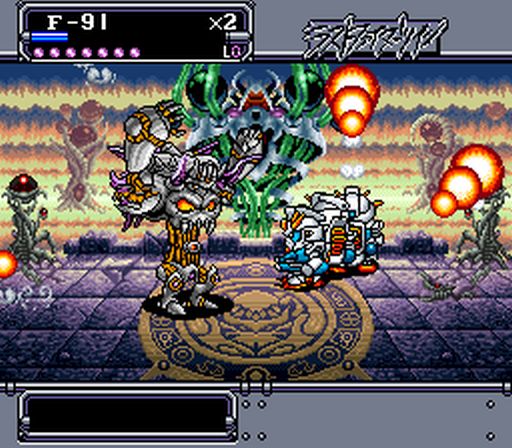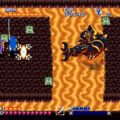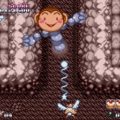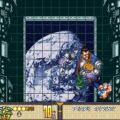Developer: Atelier Double Publisher: Nintendo Release: 01/01/99 Genre: Puzzle
Sokoban is a genre of puzzle game that I have loved for years without realizing it was its own unique thing. There is something oddly satisfying about successfully pushing boxes to plug up holes, almost on the level of Tetris. However Sokoban requires more thought as it is easy to screw up. Power Soukoban is a title that I have wanted to give a shot for years but never got around to. Once again I am kicking myself for not giving this game its due sooner, it is great.
Power Soukoban has the loose makings of a plot holding its box pushing gameplay together. Monsters from the human world are invading the world of Yokai through portals throughout the world. As a young Oni who was captured trying to escape their wrath you are the only one strong enough to break out of your cell and try to stop the invasion at its source.
At first glance Power Soukoban looks very similar to Zelda with its room by room structure and map. But that is the only thing the two games share in common. Where Nintendo’s classic series focuses on an ever expanding inventory of tools to complete its puzzles Soukoban is all about pushing blocks. Each room has a varying number of holes with a suitable number of boulders to match. Your job is to block all the holes in each room. You can push boulders but not pull them. By charging up you can create large spirit blasts that can destroy weak blocks and push boulders. This is a skill that the game will call on with ever growing frequency as you progress.
To create a sense of urgency monsters spawn randomly from each hole but until the late game do not actively pursue you. They are more of a nuisance to be honest as their presence gets in the way of puzzle solving. For defense you can spit out a weak fireball which defeats most enemies in one shot. They become stronger and more aggressive later but the game also provides item drops to deal with them. The hour glass will freeze time for a lengthy period while bombs destroy all enemies on screen. They also drop hearts to replenish health. These items drop so frequently if it were not for the game’s “story” it would be better off without enemies.
Although Power Soukoban is not a RPG it does have character progression. For every room you clear you will earn a blue or red jewel or a special item designed to help with the few boss battles. For every ten of each your health and strength will increase, up to a maximum of eight. As you progress the number you earn per room will increase making the progression smooth. Technically you do not have to complete every room. But the raise in stats will only benefit you. Later enemies are stronger and you need the health to survive. And that is to say nothing of the bosses. Although you can gain items that make these fights easy they are limited and if you miss trying to whittle them down with your weak fireballs is near pointless. So there is incentive to complete each room beyond the game being fun.
The puzzles themselves strike a nice balance between simplicity and complexity. Room sizes vary with as many as ten holes to cover to as few as two. Entering a room with a mess of blocks tightly packed in the center and trying to figure out where to start is a frequent occurrence. The first move can completely screw up the entire process and force you to restart. Yet no matter how intricate the puzzle once you figure it out it is simple in hindsight. Often the hardest rooms are the smallest ones. The way the game varies each room despite its simple concept yet remains engaging is borderline genius. This is the game’s true triumph; the dressing around sokoban means nothing if it did not nail its premise.
In spite of the picture I may have painted overall Power Soukoban remains medium in its challenge. The game literally drowns you in hearts making enemies a hollow threat. Even toward the end the puzzles never became so complex that I could not figure them out within minutes. Each location is a decent size but to the game’s credit once you complete a room it is permanent, making the little backtracking a painless process. The boss battles are the only tricky point. With enough special items they can be trivial. But if you waste them you might be better off reloading your save and trying again. But they are few so once again it is hardly a sticking point.
In Closing
I really like Power Soukoban. The game’s simple premise is executed so well that I enjoyed it from start to finish. This is a true Super Famicom hidden gem, especially considering its late (1999!) release. Its hard to find but however you play it it will be time well spent.


